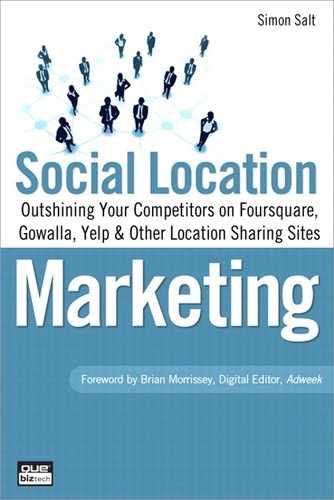4. Introduction to Location Sharing Tools
Before we get too involved in “how” social location marketing works, we are going to look at the “what” and learn what started all this in the first place. It is no accident that phones have become smarter and as they have, the marketing opportunities in the mobile platform have increased. What might surprise some readers is the reason behind this growth in the market place and how interwoven the U.S. Military, U.S. Government, and public safety were to the changes that made all the social location sharing, geo-tagging of pictures, and other various uses of GPS in our phones possible.
What Is and Isn’t Social Location Sharing?
Many terms describe tools that share a person’s location. Geo-location services, location based services (LBS), and social location sharing (SLS) to name a few. These are not all the same thing and in fact have a hierarchy that it is useful to understand before discussing how to use them for marketing.
Geo-Location Services
Geo-location services is the top-level term that covers all types of services that provide the location of a device anywhere on the planet. These devices include personal GPS devices found in many vehicles and boats (both fixed units that are a permanent part of the vehicle and portable devices). Also included in this category are the handheld GPS units used by hikers, bikers, hunters, anglers, and runners. All use some form of geo-location service that presents GPS data in a format that is useful to the particular application that the user has selected. For example, runners overlay a route on their locations and save that route for later repetition. Some runners also add additional information, such as time of day, temperature, heart rate, average speed, and so on. Someone using a GPS in an automobile might overlay location with traffic information, road construction notes, points of interest, and so on.
Personal Locator Beacons (PLBs) used by hikers, light aircraft, and marine craft are also good examples of geo-location devices. PLBs share the user’s location only in situations where the user has turned the device on. PLBs are generally activated only when the user has an emergency (a capsized boat, for example) and are intended to direct rescuers to the user’s location. Although PLBs aren’t social devices, I include them in the geo-location services category because they are not tied to cell phone service, as are other social location services.
Services such as OnStar (the in-car assistance from GM) or Lo-Jac (a company that helps locate stolen vehicles, motorcycles, and even laptop computers) are also geo-location services. These devices utilize GPS data and overlay it with their own data.
Location-Based Services
Location based services are the next level down in the hierarchy. LBSs are services that disclose the location of a user via (in most cases) a cell phone or other device that is connected to the cellular network. This term is often used when referring to social location sharing. However, I maintain that this is an incorrect usage. Location based services include social location sharing tools; however, they are much broader and include what are best described as passive location sharing tools. These include things such as the family locator services from cellular companies Sprint and Verizon in the United States. This type of service is passive in nature in that the end user (the family member) is not actively sharing his or her location. Instead, the GPS chip in that person’s phone is actively tracked via a service that ties numbers to one account. This service is primarily aimed at parents wanting to check on the location of their mobile-phone-carrying children, although it could also be used by small businesses to track delivery or service vehicles.
This technology has been extended to non-cell-phone devices that look like watches, or can be embedded in shoes for young children to enable parents to find their child if they lose sight of them. Some versions fit onto the collars of the family dog so that if it strays, its owners can locate it. These are all passive in nature—only the very smartest of dogs would be able to be trained to use a cell phone!
Vehicle tracking is a popular commercial use of passive location based services. Domestic uses include OnStar, which can provide turn-by-turn navigation instructions that are sent right to the user’s vehicle. Commercial applications include cell phones that transmit the user’s exact location, allowing, for instance, shipping companies to pinpoint the location of commercial drivers without asking them to check in.
Given that the U.S. federal government banned the use of cell phones for everything except hands-free calling for commercial drivers, and breaking that law can result not only in hefty fines but loss of their license, these services are invaluable to shipping companies in answering their most popular question: “Where is my stuff?” One such service is WaveMarket’s Veriplace Location. Aimed specifically at carriers and based on a family locator service that already had developed this service is a good example of how the B2B space can utilize location based services in a way that benefits them.
Social Location Sharing
And so we come to the crux of this book and the services that we are going to focus on. Social location sharing is the term I use to describe the various services that require a user to actively share his or her location with a network. This network is a group of people and companies with whom the user has agreed to share that information, as well as a broader network via connected social media platforms. It is the active nature of these services that sets them apart from the other services, which are passive in their nature. This active participation makes them so intriguing and so compelling for marketers. Why would someone want to broadcast their location to their own friends, let alone groups of individuals that they have, in all probability, never met in real life? We have looked at the behavioral explanations in Chapter 3, “Games People Play,” so we won’t recount those here. If you skipped that chapter, I’d encourage you to go back and read it for a fuller explanation of why people want to be involved.
Later in this chapter, we look at where the individual platforms came from, what each of their offerings are, and what differentiates them from each other. Before that, let’s consider them as a whole. Although no clear winner has been declared at the time this book was written, Foursquare seems to be a strong favorite. However, most of the marketing industry is still holding its breath, waiting to see what the behemoth that is Facebook will do with its entry into social location sharing. While not strictly a social location sharing platform, Facebook cannot be dismissed as becoming a major player in the space. Its initial entry is to attach location to status updates in a very Twitter-esque manner. However, in parallel, its team has already started to do outreach to physical locations and offer them window stickers that remind patrons to update their status with their current location and mention the venue that they are visiting. Although this is hardly likely to deal a death blow to any of the existing platforms, the fact that they are taking these services seriously enough to invest in them shows that they have a role to play in social media marketing.
In addition, Facebook’s location deal with the McDonald’s chain gives rise to the suspicion that they chose McDonald’s because of their worldwide locations more than any other reason. If Facebook decides to get aggressive with social location marketing, having a worldwide partner such as McDonald’s is a very quick way to establish a beachhead.
Balancing against this is the large scale media deals already secured by Foursquare and Gowalla—not the least of which is the one between Foursquare and Starbucks. However, no media partner is likely to turn down the opportunity to secure a partnership deal with Facebook should the opportunity rise. This potential means Facebook has to be considered in the social location sharing tools mix. At the time this book was written, Facebook still needed to adapt its mobile platform for true location sharing. Facebook’s current mobile platform extended to all mobile phone platforms, but trailed other social location sharing tools in general functionality, usability, and design. It currently has no social location sharing specific functionality, so the user is left to do all the work, which is unlikely to yield a high adoption rate.
Unlike the other social location sharing platforms, Facebook’s initial entry to the market does not offer the user any form of platform-specific rewards program or game play. Again, the lack of these features could be remedied and will certainly need to be if Facebook is going to make a serious attempt to capture market share in this space. However, given its sizable user base and that it already has a reputation for—at the very least—hosting games, such as Farmville and Mafia Wars, it is not too much of a stretch to see Facebook making inroads here. In fact, it’s not too much of a stretch to see Facebook creating an environment in which a third party could tie into Facebook’s location extension and utilize this to make a location-aware game that users could share with their network of friends.
Because Facebook mixes both personal and business environments so effectively already, a tool that could capitalize on that environment and combine it with social location sharing would be very attractive to marketers looking to leverage the enormous reach that Facebook provides with its membership numbers. Whether that would be enough to make the other platforms redundant is doubtful, but it would certainly hasten the consolidation of the space and perhaps spell the end of the minor platforms that are currently appearing and vying for market share with today’s leaders in the space.
Where Did All This Social Location Sharing Start?
Social location sharing traces its roots to 2000. That was the year the American government decided to abandon Selective Availability (SA)—a method used to scramble Global Position System (GPS) signals. Selective Availability was the U.S. government’s method for deliberately degrading the GPS signals available to civilian users, primarily on the grounds of national security. It was thought that allowing civilians to utilize the service at times when it was a priority for the U.S. military would endanger military operations. Under the Bush administration in the mid-2000’s there was talk that the President should be able to order the shutting down of parts of the service, again in the name of national security. This was discussed as a way of ensuring terrorists could not make use of the service to coordinate attacks. In addition, it was proposed that the U.S. government retain the capability to shut down other countries’ access to the GPS satellite network if that were to endanger U.S. national security. These measures have not been enacted, and given the reliance on the service by both commercial shipping and aviation, it is unlikely that any attempt to pass a bill of this nature would be successful.
Prior to the abandonment of SA, civilian use of GPS was very unreliable and did not allow for the level of accuracy that we take almost for granted today. In fact, prior to the abandonment of SA, the most accurate GPS fix was limited to about 100 yards. After these controls were released, the fun began.
Dave Ulmer is credited with creating the geo-game concept in May 2000, and by the end of the same month Matt Stum had coined the phrase “geo-caching.” The concept was simple. Take a container of some kind to a remote location, note the coordinates given by a GPS device and publish them—usually in those days to the Usenet lists. Others were then tasked with finding the container and recording their details in a log, or they would take an item from the “cache” and replace it with one of their own. In effect, it was the geek version of a scavenger hunt, using the latest technology. The use of the Internet had become fairly widespread at this time and was a communication tool of choice for many. Combining this with the now more reliable GPS system made for a great game environment. Literally, the world became the game board. The game is still popular in both urban and rural environments among those with an interest in the outdoors and in sharing little-known, out-of-the-way spots. That these geo-caching games lent themselves to both game play and technology has already been exploited by some of the newer social location sharing platforms. We will look at this later in this chapter when we take an in-depth look at each of these platforms and how they work.
In 2002, the removal of SA benefited the cell phone industry. As the rise in use of cell phones became evident—even replacing the use of landlines—the emergency services found that 911 operators were not able to clearly identify a caller’s location. Also, callers requesting assistance from 911 had difficulty identifying their exact locations. In an attempt to reduce this problem, the government mandated that all new cell phones be GPS enabled so that they work with the new Enhanced 911 (E911) system which displays the caller’s ID information as well as their latitude and longitude when dialing from a cell phone. After the technology was in place, the potential for additional services was quickly realized by other providers. However, it would be another few years before the appearance of tools that enabled this vision. Let’s look at those services as they appeared and how they differentiate themselves.
Loopt
One of the earliest of social location sharing services—and one that is still in existence—is Loopt (see Figure 4.1). Founded in 2005, Loopt has faced many challenges and has been somewhat overshadowed by the more game-oriented platforms such as Foursquare, Gowalla, and MyTown. However, it does have the benefit of being available on all cell phone platforms, something that some of the newer platforms struggle with providing. Loopt also was the first service available from all U.S. cell phone providers since the advent of Short Message Service (SMS).
Figure 4.1. Loopt isn’t the player that some other social location sharing tools are, but it is available on all cell phone platforms—something its competitors cannot boast.
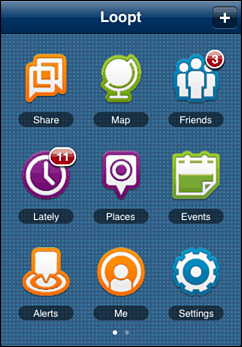
Loopt has faced adoption issues because of its method of recruiting new users via SMS. This method received a lot of attention when it was discovered that by signing up, users were in fact authorizing Loopt to send invites to everyone in the user’s address book via SMS. Further, the Loopt system did not respect the STOP message agreement, whereby the recipient could reply with the word STOP and no longer receive messages from Loopt. Loopt later addressed this issue, but in the interim new services had appeared and despite their early attempts to integrate rich content into their platform, Loopt currently trails the newcomers in acquiring a broad user base. It is, however, worth noting that the rich content model on which the newer platforms have decided to build was in fact created by Loopt, who signed deals with content providers, including CBS, as early as 2008. Later in the book we will look at the impact rich content makes as a differentiator for these platforms and how marketers can leverage it.
BrightKite
BrightKite appeared in 2007 and by 2008 had become somewhat of a darling favored by social media influencers, who touted its features and hypothesized on where BrightKite might go and how it could become even better (see Figure 4.2). Interestingly, a lot of the thoughts around where BrightKite might go were in the same direction that Loopt had started to travel and where subsequent services have gone (more on that later). For many reasons, BrightKite never fulfilled this potential, even with recognized social media influencers promoting it. BrightKite was acquired in 2009 by mobile social network Limbo—an unfortunate name because that is a fair description of where BrightKite has remained. Having lost momentum, it has been relegated to the “also ran” category. But it is still worthy of mention as being one of the first, and certainly during its heyday of 2008, the most popular, of the iPhone-based social location sharing applications.
Figure 4.2. BrightKite had its moment in the sun, but is now relegated to the “also ran” category.
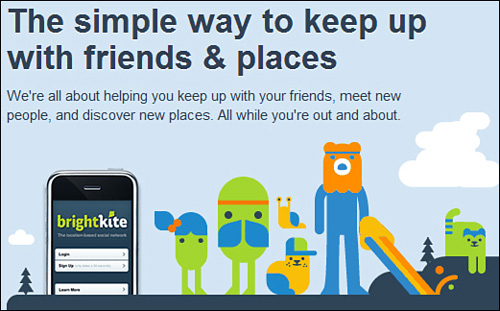
Quite possibly, the advent of a broader Smartphone user base and the multiple platforms has proven too difficult to keep up with. Indeed the “native” application for BrightKite on other Smartphones comes from third-party developers. An example of this is MyKite for the Blackberry. This was enabled because BrightKite took the first step in this arena of creating and releasing an application programming interface (API) for its platform, which allowed third-party developers to produce tools based on, and that interacted with, the data that BrightKite held. This, too, is a model that subsequent platforms have chosen to follow and one that allows the platform to grow without the original developers doing all the work.
Yelp
Although Yelp has existed since 2004, it is a more recent player in the mobile social location sharing marketplace (see Figure 4.3). It started as a venue and service review site, and as such quickly rose to become one of the top 150 sites in the United States. Yelp content was integrated into the early platforms, such as BrightKite, and continues to be integrated into newer platforms such as Foursquare. Yelp’s entry into the market came with a distinct advantage—thousands of loyal reviewers known as “Yelpers” who were already using the website to place reviews of venues and services. A number of these Yelpers are rewarded with Elite status. These Elite reviewers hold real-world events to recruit new Yelpers and promote Yelp, as well as receive recognition from Yelp.
Figure 4.3. Although its been around since 2004, Yelp is a more recent—and successful—player in the social location sharing space.
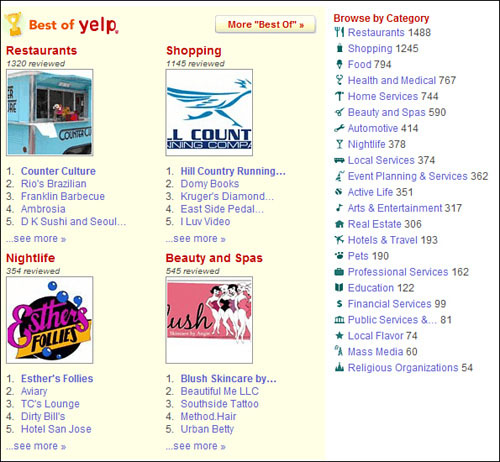
The concept of Elite reviewers is an attempt by Yelp to indicate that the person writes well enough, produces enough content, and has sufficient following to be trusted as a reviewer. There are various thoughts on how well this works. Yelpers are in fact secret shoppers of the information age. Armed with iPhone apps, they are able to make their reviews while still onsite. This makes the reviews much more immediate and, in some cases, much more punishing. With no time for reflection, a dissatisfied Yelper can slam a business onsite. However, not all has gone well for Yelp. With accusations of unfair editing, and bully tactics by sales representatives contacting small businesses and offering to have bad reviews removed in return for ad revenue, Yelp is now facing a class-action lawsuit.
The outcome of that lawsuit will be watched closely by all in the review space, not just the social location sharing space. The implications could bring a lot of extra administrative work for the newer platforms as they include Tips, To-Do’s, and other user-generated content fields.
Foursquare
Foursquare is a revised version of an earlier attempt by the same team to create a game-based social location sharing tool (see Figure 4.4). The original was called Dodgeball, an SMS-based service that was acquired by Google in 2005. It was shut down as a service in 2010. In 2007, the original founders of Dodgeball left Google to found Foursquare. Foursquare was the first of the services to introduce the element of game play to the space of social location sharing and venue review. Participants are rewarded for “checking in” at locations. Rewards are based on the location type, the number of times they check in, and whether the location already existed in the Foursquare database. Game rewards include a basic leader board, which is run weekly and ranks participants in a particular location by the number of points they have acquired. Points are achieved by checking in, adding new locations, and for multiple check-ins in a given time frame. This element provides a great deal of competition among participants.
Figure 4.4. Foursquare rewards users with Badges.
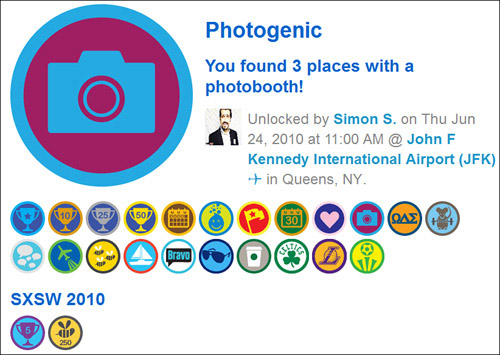
In addition, a series of badges can be acquired by participants. Some of the badges are generic, such as the Newbie badge awarded to everyone for a first check in on Foursquare. Some were originally city specific. When Foursquare first launched, it contained only certain cities in its database, and therefore game play was limited to those cities. However, this limitation was removed in early 2010 and replaced with latitude/longitude information, expanding the game play globally.
Badges are now a part of the sponsorship/advertising package that is offered by Foursquare, although many venues have found ways to create marketing opportunities around the preexisting and, more importantly, free badges. (I’ll discuss this in more detail later in the book.) Foursquare took the smart step of releasing an API early on. This has led to new applications based on their platform, which has also enhanced adoption. The API was released with not only a good set of documentation, but also a developer forum that acts as a strong community for developers. Foursquare technical team members contribute regularly to the forum, answering technical questions about the platform and making suggestions for how the API can best be used.
In 2010, Foursquare signed a number of high-profile media deals that have accelerated its rich content growth. This is certainly a good model to follow and one that was started by its predecessors in the space, such as Loopt.
Gowalla
Gowalla is produced by Alamofire (see Figure 4.5), an Austin, Texas-based software company. It launched in March 2009. Alamofire previously had success with the Facebook game PackRat. They took that gaming experience and a strong focus on design and brought it to the social location sharing space. This design focus sets it apart from other platforms. Most users of both Foursquare and Gowalla state a clear preference for the look and feel of Gowalla—the interface and the digital objects that the platform rewards users with.
Figure 4.5. Gowalla has a strong focus on attractive design.
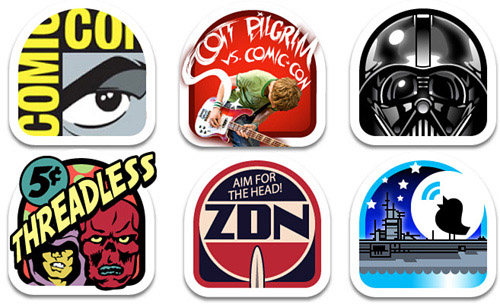
At the end of 2009, Gowalla received $8.29 million in Series B funding. Gowalla focused on the iPhone platform for much of its growth, not releasing a variant for Android or Palm until 2010. As of June 2010, a Blackberry application was still awaited.
In February 2010, Gowalla followed in the footsteps of its main rival Foursquare and released an API for developers to work with. This has certainly aided its adoption and is leading to new applications being built for Gowalla. However, without the strong community focus that other API’s enjoy, this is likely to be a harder win. Gowalla has also followed Foursquare into the rich content space by signing a deal with the Travel Channel and other media outlets.
The Travel Channel deal is a great fit for Gowalla because one of Gowalla’s unique features is “Trips.” This allows users to complete check ins at groups of locations, and as they do so work toward completing a Trip; having completed a Trip, the user earns a new reward. Gowalla added to this rich content mix in May 2010 by signing deals with both National Geographic and the Washington Post. The Washington Post deal creates trips that are based on content in the “Going Out Guide,” whereas the National Geographic deal sees the creation of 15 unique walking tours of cities across the United States, Canada, and Europe. These types of deals help to differentiate the Gowalla platform from its competitors. Though many of their deals have focused on travel, that is not all they are restricted to, and marketers looking to utilize this platform should think beyond trips and travel information. At its core, Gowalla is definitely a social location sharing platform capable of offering real opportunities to organizations looking to make it work for their customers and potential customers.
Gowalla’s game play mirrors PackRat by focusing on the trading of digital objects. This concept is core to Gowalla, with users being able to acquire new digital objects at various locations as they check in there and leave other objects behind for other users to collect.
What Gowalla lacks at present is a clear path for users to be rewarded by venues, unlike the “Mayor” route in Foursquare. However, with the much greater funding that Gowalla enjoys, it is only a matter of time before it unveils a method of integrating with the venue owners who are looking for a way to reach Gowalla’s growing audience. That is not to say that marketers can’t and shouldn’t leverage Gowalla right now. It would be a huge mistake to ignore the Gowalla platform and its user base. You’ll learn more on how that can be done in later chapters.
MyTown
As the popularity of social location sharing grows, so does the number of platforms vying for a share of the marketplace. Each tries to bring something unique to the space or to take a variant of some other platform in a new direction.
MyTown (see Figure 4.6) is one such platform. MyTown incorporates Monopoly-style game play into the social location sharing space, enabling participants to buy and sell their favorite venues. Players are rewarded with increased ability to buy new locations the more frequently they check in. Players can also leave comments on a venue when they check in and receive rewards for doing so. MyTown has taken the venue promotion in a different direction after signing a deal with the clothing store H&M. Rather than simply making the rewards dependent on the local venue, MyTown users who are near an H&M store are alerted to discounts in the store by finding that H&M merchandise is available in the game. Checking in at the H&M store then unlocks discounts available in the store. This builds both loyalty to the game and to the venue. This is the first of this type of deal to incorporate a form of “push” notification, but we can expect to see more of this type of marketing as the social location sharing space grows.
Figure 4.6. Booyah’s MyTown brings Monopoly to the iPhone.

Other Social Location Sharing Tools
The social location sharing space continues to add new services all the time; PlacePop, BlockChalk, Bump, FoodSpotting, and Graffiti are all trying to be the next big thing. All have something to offer, but given the lead held by Foursquare, Gowalla, MyTown, and Yelp, it will be a hard struggle for any newcomer to grab real market share. Focusing on niche users might be the way we see the space develop, though undoubtedly we will see some shake out in late 2010 or early 2011 as platforms merge or disappear.
Picking the right platform to align with is definitely an important part of developing a social location sharing marketing plan. The rest of this book focuses on just that. It is important to bear in mind that although this book covers the existing technology and to some extent presents visions of the near future, all this social location sharing is happening in the real world, and that is ultimately where the audience that any organization is trying to reach exists. The technology will get you only so far. After that, the organization must work out how to close the final gap between technology and the real world.
Real World Uses for Social Location Marketing
Marketing communications have always been about delivering a message to a receptive audience. Social location marketing falls into this category. However, the twist that social media has brought to marketing communications is the expectation of the audience that they will, at some point and in some way, “meet” the brand in the real world. Exactly what that means varies from brand to brand and from audience member to audience member.
In some cases the “meet” is conducted through blogger/influencer outreach. In others, it is competitions. Whichever direction an organization chooses, it has to realize that this is part of the deal in using social location marketing as a channel. The advantage that social location sharing offers a marketer is that identifying those they want to “meet” is extremely easy. After all, those people are already broadcasting their use of the location. So the real world outreach is made that much easier. In addition, after the outreach is conducted, it is easier to promote both as an organization and through the audience member. People who are broadcasting their location are unlikely to be wallflowers, so if they are treated well by a location, organization, or brand, they are going to share that experience on other social media platforms. The connectivity that is presented by social location sharing platforms is another compelling reason why choosing social location marketing as an entry point into the broader social media world makes a lot of sense to organizations of various sizes. Instead of trying to understand what content they should be producing and where it fits, they can rely more on providing an outstanding customer experience and let the customer share that for them.
As we have already discussed, a total reliance on customer-generated content would be a very flawed strategy. However, given that the majority of the content on social location sharing platforms is customer generated, this does give an increased opportunity to use social location marketing as the point of entry for organizations that are looking for low-cost, low-risk methods of entry to social media. Companies gain the benefits of social location marketing while doing what they should be doing anyway, which is providing a compelling reason for customers and potential customers to build an affinity relationship with them.
Passion brands have long had an easier time of building affinity than the rather more mundane brands. For example, it’s easy to understand why Disney has little problem building affinity, whereas an accounting company might not attract the same level of enthusiasm. However, great customer service, no matter where it is provided, will always produce increased levels of affinity. Social location sharing tools allow organizations to focus those efforts into tangible communications that not only provide an improved customer experience but also acknowledge that the consumer has a choice and that the consumer chose that particular organization to do business with.
Saying thank you, which is all a customer loyalty/rewards program is, has always been key to any small business. Larger brands have relied on volume rather than individual touch points. Social location marketing offers the opportunity for larger brands to not only continue with their usual method of operation but to incorporate the types of outreach that are usually more familiar to customers of smaller, more local, operations. As with any of this type of activity, scalability is always the challenge, and operational integration is key to this. Whether that is technology, staff training, a mix of both, or more involved cross-functional integration, it is essential if these tools are to provide value to the larger organization and ultimately value to the customer.
Case Study
Venue: Capital Hotel—Little Rock, Arkansas
Participant: Amy Bradley-Hole, Marketing director
Background: The Capital Hotel is a boutique hotel in Little Rock, Arkansas. With 94 rooms, it has long been perceived as an upmarket location, out of the price range of the younger local residents of the city. The hotel has two eateries—a fine dining restaurant and a bar and grill. The latter has a more relaxed atmosphere and would be very suitable for the younger crowd if only they knew of it. The hotel underwent a massive renovation over a two-year period, reopening in late 2007. The marketing manager wanted to change the perception of the bar and grill and reach out to the local community of freelancers, social media enthusiasts, and those who were more “plugged in.” The first step toward this was to host the Little Rock Tweetup. This immediately positioned the bar and grill as being part of that community.
The Move to Foursquare
Amy was already a user of Foursquare and decided that incorporating Foursquare into the marketing communications plan made sense. She had noted that customers had already created the venue in Foursquare and were checking in. She reached out to Tristan Walker, VP of Business Development at Foursquare, to register specials and got a rapid response. She also talked through the concept of having a sponsored badge, but at a starting price of $10,000 this was out of her budget range.
Having decided that the Capital Hotel would be a venue, the next step was deciding how to promote that fact. The Capital prides itself on its boutique feel. That guests feel more like they are staying with friends at their home than at a hotel is central to the mission of the hotel. Putting up signs to tell guests and visitors to “Check in on Foursquare” would run counter to this core principle.
Instead, the wait staff in the bar and grill were trained on Foursquare use and were encouraged to ask people who they saw with cell phones if they had checked in. If the guest or visitor didn’t know about Foursquare, the staff were trained to show them how to find it on their phone and how to use it.
The team is quick to congratulate Mayors on Twitter. In fact, one Mayor started a buzz all of his own. When the team reached out to congratulate him, a group of women who were also in the bar started a conversation on Twitter about how cute the Mayor was!
Amy made a conscious decision to keep the rewards for Foursquare lower priced but still attractive. New Mayors receive a free Capital Hotel T-shirt; those checking in for the tenth time get a free dessert. There are some smart thoughts behind these prizes. If someone does game the system to become Mayor, what they get, the T-shirt, is in fact free advertising for the hotel. If someone gets a free dessert, chances are that they are going to buy an entrée and drinks to go with it. By pegging the prizes at a lower cost to the hotel, the risk of someone gaming the system is reduced. As Amy points out, “Higher value prizes attract scammers.”
These rewards have to be created in association with Foursquare directly by completing a form on their website and at the time of writing cannot be created directly through the Foursquare interface, which might become a barrier to adoption as the space increases.
What was the result? The hotel experienced a 20% increase in visits from the target audience crowd in just six weeks. The first Mayor was “crowned” in two weeks and ousted just one week later!
So what would Amy like to see as new features in Foursquare? Not surprisingly, better stats. Because while all this game play is great, if you can’t tie it back to the rest of your marketing efforts, it becomes rather meaningless. In addition, a better way to communicate with those that check in, on a permission basis, would definitely enhance the ability to build community.
Let’s see if Foursquare rolls these features out in the near future.
You can find the Capital Hotel on Twitter at @CAPITALHOTEL, @ASHLEYSLR, and @CAPITALBARGRILL.
